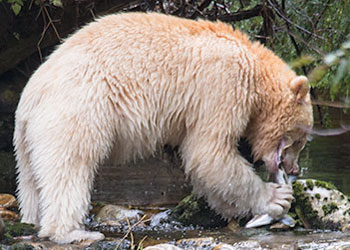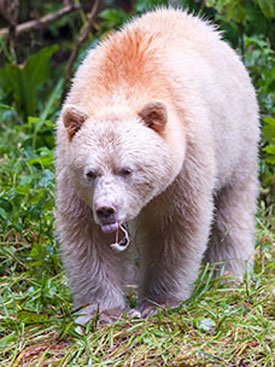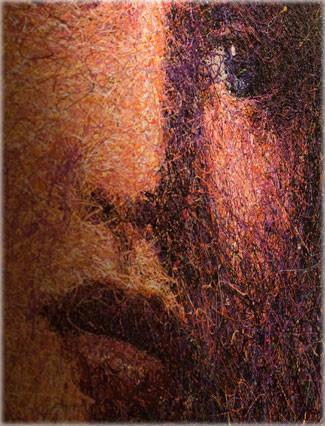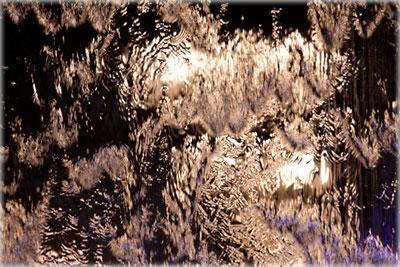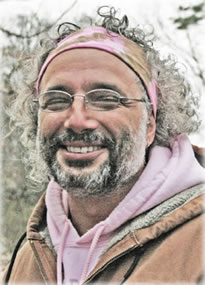Navigate Signs:
Recent Posts:
Archives
Featured links:
Spirit Bear Listening
By Bev Dulis
I didn’t start the year — or even the summer — thinking about bears. It’s been a year of big, hard changes for me, and I’ve been learning that my heart is the one voice I need to listen to. While focusing attention on my heart, I have been surprised to hear other voices as well. Some of those have been bears’.
This summer I suddenly found myself needing to go look for Spirit Bears, a rare type of black bear with a white coat, found only on the northern coast of British Columbia. The internet quickly set me straight on where these bears live, and helped me reserve the last available bunk on a sailboat traveling through their territory, the last motel rooms in two key stopover points, and a seat on the final ferry run of the season that would connect me with the charter boat.
Okay, I got it — one of those Meant-To-Be trips. I later found out that most of my fellow travelers had reserved two years in advance, and that the skipper and his partner had debated whether they would even book my cramped bunk that trip. It seemed the bears were in charge, adding me to this trip.
I would spend a week cruising toward a potential — not guaranteed — sighting. The usual words describing the Spirit Bear, in addition to rare, are “shy” and “elusive”.
Spirit Bears live in a small area on the west coast of Canada that encompasses the largest stretch of coastal temperate rainforest left in the world. The islands and rugged coast go by the name Great Bear Rainforest. The waters and land there are full of life: shellfish, halibut, seaweed, salmon coming home to spawn and die; seals, porpoises, humpback whales, sea lions; bald eagles, sea birds, water birds and gulls; on land — native peoples, black, white and grizzly bears, wolves, river otters, deer; and on the water — Canadian fishing boats and those traveling to and from Alaska, a few ecotourism boats, BC and Alaska ferries, and immense seasonal cruise ships.
It’s a lush ecosystem, on land and in the water, and a busy marine highway.
I chose the slow route north over a quick flight — a ferry to Vancouver Island, followed by a long drive. The last part of my approach was a 13-hour trip on a small BC ferry nicknamed the Shoebox, running part way up the coast. I shared the Shoebox run with a handful of tourists and a large number of Canadian First Nations people.
The purser addressed me by name at one point, and told me I only had to show my passport once getting off, instead of the usual three times. I was distinctive as the only American woman traveling solo.
I spent time chatting with Michael, the harbor master at Bella Bella, who explained this excess bureaucracy in northern ferry travel. A few years back, the BC ferry Queen of the North failed to make a sharp turn on a normal run, smacked into a rock, and sank within two hours. The Gitga’at peoples north of Bella Bella came out in small boats, at night in bad weather, and saved all but two of the passengers and crew. Human error was blamed for the accident and regulations had proliferated afterwards.
Michael also introduced me to the proposed Northern Gateway oil pipeline project that would run from Alberta and end at Kitimat, up a long inlet from the bear islands I was heading for. At Kitimat, the crude oil would be loaded onto supertankers to thread their way east-west — not the usual north-south passage — in any weather and seas, through the tightly clustered islands that make up the Great Bear Rainforest. The oil would fetch a higher price in Asia. Huge tankers would run right beside the wreck of the local ferry, which is still leaking fuel, and right beside the rock that sank it. One small mistake could easily release millions of barrels of caustic tar sands oil, mixed with solvents to help it flow through the pipeline. A single accident would cause untold damage to the pristine wild coast, and all the human and animal life that depends on its well-being to survive.
Finally, Michael gestured to a small cluster of Heiltsuk salmon boats waiting to unload at the processing plant, as we pulled in to dock at Bella Bella. The Heiltsuk people, like all the native peoples of the Inside Passage, depend on the sea for their food, their income, and their transportation. None of them like the tanker project.
The next morning I boarded a sailboat headed north to bear country. There were 11 of us, mostly Canadian with a smattering of other nationalities. We had all come long distances hoping to see a Spirit Bear, understanding we might have come a long way for nothing. The streams might be too dry for salmon, the numbers and timing of salmon returning to spawn are never predictable, and the Spirit Bears are the least predictable of all. But in some way we had all heard the bears call, and we came.
Maybe it was the magic of the place, or the high ratio of other large mammals to humans. As our group traveled through the islands, I was amazed to develop an ear for different species having distinct pitches — the low hum of the humpback whales, and a slightly higher pitch for the sea wolves we never saw. Grizzlies had a middle pitch signaling their presence, and black bear came through higher yet.
At the top of the scale, Spirit Bears sang with the voice of a mezzo soprano alternating with a clear crystal ping. As we approached the small island where we hoped to see Spirit Bears, the high voices grew excited, chattering like The Chipmunks. The white bears were very pleased our group was coming to see them.
I had the usual human expectation that my trip was about me — seeing the bears would heal me and change me. At the very least I would be struck with awe by the experience. While all of that certainly happened, it seemed the bears had called us because they wanted us to come, for their sake.
In the morning we went ashore in full rain gear and knee-high rubber boots. The rains had started the night before, which was good news for the salmon runs. We carried thermoses of hot drinks and plastic covers for our cameras.
As we were dropping down the trail toward a creek we came upon a white bear in the water right in front of us. He was moving slowly upstream, watching for salmon. An older male with a gimpy leg, he was the most beautiful creature I’d ever seen — dripping wet from the rain and the stream, his coat ivory-colored with an overlay of orange from the crown of his head down past his shoulders.
Our bear moved slowly but steadily, like a furry all-terrain vehicle, as he climbed over and under, and traveled down, huge logs that crisscrossed the stream. He mounted large rocks in the water, to look for salmon sitting still in pools — much like a circus bear perching on a ball. He plunged at top speed on a fish — and missed. He picked a dying salmon from the water and chewed on it a while.
He eventually crossed a log in the distance and disappeared. After getting our breath back, with lots of excited human chatter, we settled in to wait, hoping that wouldn’t be our only sighting of the trip.
Our bear returned after a bit, working his way back down the stream. He cut into the woods as he got closer to us, then came back out on the bank beside a partly eaten fish. He settled down less than 25 feet away, directly in front of us, and made repeated eye contact while he delicately ate the rest of the fish. Like a house cat, he cleaned flesh off organs he then spat out. When there was nothing left to eat, he headed back into the woods for a nap. Hours later he came back out for one last look at us, then made his way downstream and out of sight. I had a clear knowing we’d see him again the next day.
Over the next couple of days we spent more time with our first bear, and met one or two other Spirit Bears and several black bears — big, glorious bears pouncing on salmon with huge splashes, and carrying them off into the brush to eat them. They reappeared with paws and muzzles smeared with blood, ready to grab the next fish.
I heard a clear bear request to act as a spotter, since we spent most of our time on a platform high above the stream. I could point out salmon, but not how deep the pool was or how easy it would be for the fish to swim away, or whether a bear could stay invisible until the final lunge. I was useless as a fishing aide, understanding none of the key bear concerns, and they didn’t ask again.
The bears took salad breaks of skunk cabbage, and dug in the mud to return with blackened faces. They shook off rain and stream water like huge dogs. We watched them, photographed them, and videoed them, for hours. One came within 10 feet of us, on the same side of the stream, constantly glancing at us. Our guide gently encouraged him to keep moving. Another pooped right in front of us, totally relaxed and trusting. Sometimes there were other human groups nearby. The bears repeatedly cut away from the stream into the brush and forest in front of them, to reappear in the clear on the bank in front of us.
The bears not only trusted us, they liked us.
Eventually the last bear moved out of sight downstream, we were out of time, and we had to leave. Back on the boat I kept saying, “The bears liked us!” A European woman on the boat suggested in halting English that was because we showed them respect.
Respect is a key factor, for sure. The oil companies don’t respect the bears, or the whales, or the native peoples.
Listening is another key. Listening and respect go together, whether we’re listening to our own hearts, or people we care about, or people and beings a little further afield — like Spirit Bears in the Great Bear Rainforest. I heard the bears call me, and I came. Much of what I heard from the bears I don’t pretend to understand, and that’s just fine. But I kept listening, without trying to force a translation, or some human meaning, onto what was coming through. Listening, allowing, giving them space, being with them in total awe and delight — maybe that’s what really mattered. Maybe that’s why the bears liked us.
To learn more about the Great Bear Rainforest and the threats facing it, visit www.pacificwild.org or www.sierraclub.bc.ca.
About the author
Before this trip, Bev Dulis had no special relationship with bears. The one time she got close to a cub up a tree, bleating for its mama, she high-tailed it out of there. Bev has contributed several underwater photos to Planet Waves, but creaky joints are causing her to rethink northern scuba diving. Shooting in downpours in the rainforest is her way of transitioning to dry photography.
www.waterworksdesign.net and www.bdulisphotography.com
Posted in Featured Articles
Leave a comment
Libran Listening
By Suzana Da Costa
Just as Libra bridges the gap between discerning Virgo and all-or-nothing Scorpio, it’s through listening that we refine and define ourselves into a truer, more authentic version of who we are. Libra, the midpoint of the zodiac, enables us to bridge the integrity of who we are as individuals to the outside world and what is beyond our control, just as listening provides access to the information that we need to help us to navigate in our lives.

Art by Sally Smith.
This process of navigation can be exacting and difficult to achieve, and relates in many ways to the decision-making process that ticks within each of us when we express our own Libran qualities. Nobody knows better than a Libra that everything we choose in our lives rests on the fulcrum point of a decision, and every decision holds the opportunity to transform. No matter how small the issue may be, Librans know that it will either affirm who they are and what they stand for by re-enforcing what they know, feel and believe to be true…or not.
It’s no wonder so many of us are happy to let others make decisions for us and run around with our hands over our ears: listening requires great strength of character. To listen is to open yourself up to what is outside of your current paradigm, to be vulnerable and willing to be susceptible to what is outside of your known self, your identity.
However, if we can uphold the higher octaves of expression offered to us by Venus (Libra’s ruler) and Saturn (Libra’s exaltation), then we’re granted the ability to listen and relate to the world around us deeply and gracefully, much like a tree that ‘listens’ to the wind by bowing yet remaining steady.
It’s through the influence of Venus that we’re provided with the desire to, as well as the capacity for, relating, just as it’s through listening that we accommodate others. This is something that Libra is naturally attracted to, and one of the reasons why this is the sign of the diplomat, counselor and mediator — in the act of listening to another person, we’re privileged with the gift of holding and integrating a piece of that other person, that other individual. Here is where a crucial decision is made in our relation to others and the world outside us.
If we choose to accept what is offered, we’ve made a connection and supported it, deepening the partner end of the spectrum because we’ve made room within ourselves for another person’s truth. However, it’s clear that there will be a challenge here, especially if what is offered challenges our own truth. How willing are we to adjust and make space, or how willing are we to resist and hold our ground?
The very clear presence or lack of Saturn operating in an individual identifies those Librans who are rooted and secure in themselves and those who are not. Without Saturn’s influence, too much accommodation is allowed; a person will change his mind on a dime and follow anyone who tells him or her something that they want to hear. Without solid grounding of themselves, they’ll happily give themselves away, providing no resistance to what the person (or the world) before them proposes. This allows them to escape the responsibility of deciding and also allows them the luxury of being lazy (a shadow trait contributed by Venus).
Without the grounding influence of Saturn on Libra’s airy nature, we don’t have the integrity required for a deep connection with others and ourselves, and because of this we’re denied the opportunity to connect with others and to allow their influence to transform us. By not accepting the gravity and weight Saturn lends us, we’re too buoyant to delve deeper and life continues to deliver what we already know. Our current paradigm never shifts and we just wind up being surrounded by empty chatter.
However, for those individuals who are brave explorers and are up for the challenges of Saturn, the capacity for relating is strengthened and it becomes more focused and precise. There is no need to give oneself up for another if we can exercise control and balance in light of new information. If we can maintain a state of vigilant and open attention, hold a space without resistance that is solid, where we are still and steady in mind, body and soul, then true listening can occur.
In between resistance and acceptance is a fulcrum point that allows for two opposing points of expression, and that’s where Libra wants to live all the time. It’s in that precious slice of time when self-actualization has occurred and all the information inside and outside of us is balanced and in harmony. We feel secure and know what is true and false for us.
Unfortunately, nobody gets to experience this beautiful place for very long. If we really pay attention to the worlds inside and outside of ourselves, we know we’re dynamic and constantly changing, and that we live in a world that is also in constant motion. We’re required to process that information to survive and adapt.
Just like the motion of the scales that balances itself to find that fulcrum point, what makes Libra functional is not the end result of the weighing (stasis), but the dynamic give-and-take that is necessary to come to that point. It’s in that very act that we find a great vulnerability, for we are exposing ourselves to information that may change the course of our direction.
However frightening this may be, it’s as necessary for us in our process of self-definition and self-actualization as it is for the snake to shed its old skin. We need to leap across the unknown in order to achieve a new level of understanding and knowing.
In our willingness to listen, as well as our responsibility to exercise discrimination in what we accept, we call forth our own personal truth. This is what ultimately allows us to evolve and grow into more authentic versions of ourselves. It provides us with a space to define our deepest convictions, but also allows us to keep our hearts open to others; it’s what we use to lead us to our next adventure and what equips us to overcome the challenges we will encounter. Listening is what allows us to bridge the gap between between knowing and unknowing, truth and lies, rejection and acceptance; peace and war. It’s the bridge that connects us all.
About the author
Suzana Da Costa is an emerging healer, currently practicing astrology and massage
therapy in Montreal, Canada. She especially enjoys supporting others during periods of transition and change. She can be reached at suzana.heartstar@gmail.com for consults or writing requests.
Posted in Featured Articles
Leave a comment
The Silence Between the Words
By Janey McCarthy
Listening — attentively, respectfully, and open-heartedly — establishes an honest connection with another in the present moment, when we choose to authentically express who we really are.
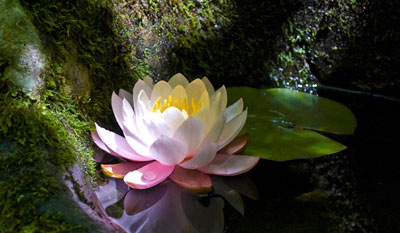
Art by Sally Smith.
Me in a state of silent exclusive receptivity, listening. You in a place of sharing, speaking your gift of personal expression. As a species, we all long to be ‘heard’. Seen. Acknowledged. Valued for all that we uniquely are.
In the silence between our words, have we actually created an opportunity for much more than simply an exchange of ideas?
In these inaudible moments our nonverbal listening senses hear much more than is being said. We intuitively accumulate a myriad of impressions through touch, sight, sound, smell and taste, now consciously monitoring what form, quality and quantity of input will be selectively encoded and responded to.
We’ve all experienced this multi-dimensionality during interpersonal connections, and benefitted from the increased depth of conversational understanding we derive, similar to corresponding via email versus communicating in person.
Counterintuitively, this enhanced awareness of our own body’s responses and attunement to the outer world doesn’t make the experience more intense, uncomfortable or unwieldy. Instead, we feel more relaxed, centered, intertwined with “the other”, as if in some interlaced tandem dance movement.
Although the interactive speaking-listening cycle is perceived as an enormous air-time consumer, statistically it is our nonverbal exchange which repeatedly and more reliably gets “heard”. According to researchers between 55 percent and 93 percent of performance and communication effectiveness is determined by nonverbal cues.
What arises in these self-muted moments is a reunion with our true selves, as we expand our view beyond how we’re being received or relatively valued, to being fully engaged with all our senses, feelings and surroundings, prepared to listen to ourselves.
As individuals in a vast human collective we can feel so anonymous, unrecognized, disregarded, and starved for attention, often exacerbating how much we talk versus how well we listen…especially to our own inner voice.
So who’s not listening to whom?
All one needs to do is look at the voluminous number of blogs, spawned by an insatiable desire for individuals to attract collective attention, to be heard. I believe this unfulfilled need emanates from our projection of not listening to (or valuing) ourselves, sadly reflecting back to us a lack of personal self-worth. This has been especially true of women, who for centuries have been bought, sold and traded as possessions, re-enforcing the message of human devaluation, feeding this insecurity.
At this turbulent juncture in human evolution a pertinent question emerges:
Can we choose to do this for ourselves, to begin compassionately and actively listening to that unrelenting inner voice, imploring us to get what we need? To express who we really are? To trust our feelings, sensations, and intuitions, and ask for what we want, need, and desire?
We watch ourselves repeatedly (over)invest emotionally, physically, financially, intellectually, and spiritually, in relationships with others … because the human need and experience of deep, loving, connectedness brings meaningfulness, passion and purpose into our lives.
So then why are we not as masterful at the art of listening to ourselves? Especially since it appears we have already acquired this skill set when it comes to being in relationship with another. What personal beliefs might conflict with the instinctual desire to get our own needs met?
Belief systems are inherited and learned. Some are borne out of ancestral teachings, societal mores, or religious and national laws, often feeding our insecurities rather than anchoring our sense of self-worth. Historically, and currently, we observe populations as more easily controlled if they hold self-perceptions of being undervalued or made to feel disempowered, spiritually weakened, or denied the freedom to individuate.
So, what commonly held beliefs might habituate and reinforce our inability to ‘listen’ to our own inner voice?
- It is ‘better to give (our attention to another) than to receive (attention from ourselves)’. Haven’t we been taught it is shameful to prioritize our own needs over others?
- We don’t deserve to be happy. Weren’t we born with original sin? Hasn’t it been our historical collective path, to be-in-suffering, ever since we equated the archetype of The Martyr to being ‘almost’ divine?
- It would be too demoralizing to ask for what we wanted only to discover how self-denying we can be to ourselves. Would we continue to ignore our needs in favor of others’ demands on us?
- We don’t have the courage to listen to what we silently tell ourselves we need and then actually make the effort to invest in ourselves to get it. Can we trust ourselves to do what it takes to get our needs met? Will we dependably show up for ourselves as we do for others?
When will it be your time to decide to make this commitment to yourself? That you will no longer be a slave to your behavioral past, or a prisoner of someone else’s dream or dictate of what your future must become?
The act of listening to ourselves, and becoming personally responsible for getting our needs met, establishes a foundational platform of safety and trustworthiness, where our emotions find their voice. Only when we listen will we each stop struggling with ‘the other’ for prominence, dominance and control over our own lives, because we will have ceased struggling with ourselves.
About the author
1998 was a life-altering year for Janey C. McCarthy. She became a professional Jungian Karmic astrologer, after enjoying 25 years in IT, three in human resources and organizational development, and five in art education. Out of her new world emerged a passion to help clients bridge their spiritual and material worlds, listening to their own stories told through the ancient archetypal language of astrology and sacred geometry. Janey is originally from Philadelphia, though she has chosen to build her ‘nest’, for now, in the Baltimore area with her soul mate and two kitties.
Posted in Featured Articles
Leave a comment
Culture of Conversation
By Calvin Hutcheon
America, theoretically, was built around conversation, the stuff of democracy, yet today we seem to be struggling when it comes to listening. These last four years have been characterized by partisan squabbling. Many times it looks as if the only thing that can be agreed upon is that there will be no agreement. Far too much energy is put into fighting along the party lines, as the push to keep Susan Rice from being appointed Secretary of State demonstrated.
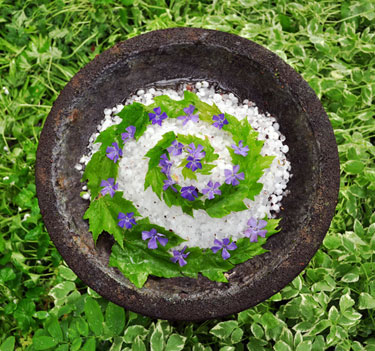
Art by Sally Smith.
Unfortunately, this has become normal. Conversation no longer characterizes the climate of American politics. Could this, in the end, be a problem that has less to do with stubborn individuals and more with a system that can’t adapt to the changing needs of the country?
While many want to have bipartisan conversation and many want to have a more collegial atmosphere, there are no longer the social guidelines or expectations in Washington that facilitated the camaraderie that were present only a few decades ago. No longer are there shared dinners between both Democrats and Republicans and no longer is there a serious effort to get to know colleagues across the ideological isle. There are fewer opportunities for interaction and there is no longer a culture of protocol in which to approach those not in your party. This normlessness naturally makes it difficult to function, but that’s not the only weight on the backs of senators.
They must reconcile traditional ideals with the expectations of today. This is no easy feat, partially because American values, such as freedom and self-determination, as well as representation in government, are open to interpretation and the whims of changing times. Expectations are imposed not only by voters, but by party guidelines and the influence of special interest groups along with lobbyists. While this stalemate has been bewailed by the media, there has been very little examination of what has caused it.
Institutions are slow to adapt. With change being fueled by advancing technology, governing bodies are struggling more and more to keep up. Normal is shifting so quickly, the political culture is struggling to remold itself. Congressional dysfunction is a symptom.
Alienation and division within politics and within American culture is a sign. While political bodies have always struggled to keep up with the movements of the times, the disconnect today is more pronounced and will continue to lag. As society, technology and attitudes continue to progress, institutions will fall further behind, not able to change quickly enough. Empires that cannot adapt shatter; institutions that cannot evolve split at the seams.
Social norms are the glue that holds a society together. They are the unspoken rules that shape the way we interact. As many old guidelines, such as slavery and sexism, have fallen out of fashion there is an opportunity to create new ones. Recognizing that we are subject to these unspoken rules could allow us to use them to our advantage, creating a more just and fluent society.
Right now, though, we are building a culture of anomie. Good examples of this attitude are: the movements to secede from the U.S., the Tea Party and the impeach Obama movement. At a time when conversation is desperately needed, by the looks of it, America is headed in the opposite direction.
Like the halls of Congress, my grandparents’ cul de sac faces many of the same challenges: difficulty fostering community and conversation. Though there have been some attempts to rectify this, such as the construction of small parks and a “community center,” they don’t appear to be working.
Planned communities are not meeting needs, either. Many of the people who live in these places are very busy, with both heads of household working. There is little time for socialization with their neighbors, let alone with their own families, yet there is the assumption that people will find the time to talk, be it over the garden fence, on the front porch, or in the parlors of neighbors.
This is unrealistic. Community is vital and I believe we must adapt so as to balance the obligations of work with the potential support of a neighborhood, but how can this be done?
Communities are unfortunately not built; they arise organically, from every conversation, discussion and interaction. So no matter how many parks are laid out, there will not be an underlying change without individuals conferencing with one another. However, the subdivision does offer an unusual opportunity: an equal playing field from which to create a community.
Uniform housing and unexceptionalism have, for the denizens of the cul de sac, created a classless pocket. There are very few dividing factors in these ironically communistic places. This lack of stratification, polarization, partisanship and generally strong emotions would make it an ideal nest for a young, earnest community.
Creating a culture of conversation is a balance, of course. It must arise organically, yet with goals in mind. The people in it must be motivated by each other (it helps when the group is fairly small — below 200 people — one of the reasons neighborhoods are ideal for its birth) and open and respectful of ideas put forward. This town hall meeting-style layout allows the best ideas to be heard and promoted, and the combined brain power of the group to be utilized. More dynamic solutions to local problems can be agreed upon in this fashion.
Occupy Wall Street has been a sterling example of this. The movement was a success, if only for a short time, not because it had uniform demands or a crystal clear goal, but because it didn’t. Zuccotti Park was a centerpiece of conversation. Ideas were floated and discussed, and issues brought up. No one claimed to have the solution, but the consensus was that together, we could find it, through listening to one another.
While the world may be confusing, with technology making interactions more distant; while our lives remain hectic and the whole current political climate may seem discouraging, one simple act can counteract that: talk with your neighbors, council with your friends. Have lunch under a tree and have a friendly discussion.
We can decide what is important to us. We can decide how to define our social guidelines. Why not make honest, down-to-earth listening a prominent feature in the future we are building? Slowly but surely, this mindset can permeate all walks of life. If a culture of conversation can become part of everyday life, it will, in turn, become part of everyday governance.
Take the first step. Listen to what your friends, family, co-workers and neighbors have to say. Create a culture of conversation within your own household, and within your own neighborhood. We have an amazing opportunity here, to create customs for good in our ever-changing world. We are the elements of change and the time is upon us.
About the author
Calvin Hutcheon is eighteen years old, and spent a lot of his youth abroad — living almost three years in the Indian sub-continent. In the past year or so he’s been traveling in the U.S., rediscovering his home country. While on Vashon Island, Washington, he founded the Insomniac Storytelling Society, a group that celebrates myth, magic, rhyme and improvisation.
Posted in Featured Articles
Leave a comment
Listen to Your Heart
by Liliane Mavridara
“Listen to your heart. It knows all things, because it came from the Soul of the World, and it will one day return there.”
“Why do we have to listen to our hearts?” the boy asked.
“Because wherever your heart is, that is where you will find your treasure.”
From “The Alchemist”, by Paulo Coelho
I was introduced to The Alchemist in my mid-twenties during a full moon celebration on a Greek island. It became my bible, a book I kept by my bedside for years as I started listening to my heart and its prompts, that many times seemed illogical, crazy and were asking me to do things I was not willing to.
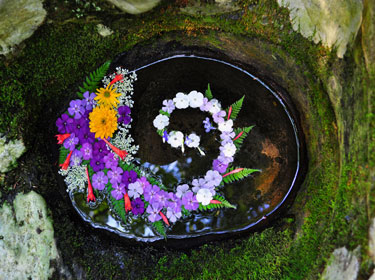
Art by Sally Smith.
I remember waking up one morning, soon after I had read the book for the first time, during my usual 7-day-a-week/17-hour-a-day workweek, not being able to move my neck: an “unexplainable” condition that had me wearing a neck cast and going through physical therapy for more than two months. This was the first wake-up call to something greater that was at play in my life, something I had forgotten over the years because it was not convenient to listen to.
Now, almost 17 years later, I’ve learned what it takes to listen and trust one’s heart, a process that initiates the Hero/Heroine’s journey. Going through such experiences builds character and courage, eventually setting the stage to lead by example and inspire others by what is possible. The challenge comes when listening to your heart requires you to go against others’ expectations and societal norms.
In my work with women’s empowerment, I have found that for many, even if they have a vision and want to make a difference, they get into situations (primarily in intimate relationships) where they either question or stop listening to their heart and the truth it holds. They fall into roles and societal expectations of who/what they should be as mothers, daughters, wives, executives, and over time listening becomes a nightmare.
This is primarily so because listening to their intuition may mean that they will make someone feel uncomfortable or disappointed, or that they may have to leave a job, a marriage, a familiar situation or location. However, the refusal to listen inwardly (whether conscious or not) does and will manifest in one way or another outwardly. It may be experienced as inner conflict and turmoil that leads to sleeplessness, depression, indifference, or physical symptoms like migraines or my “inexplicable” neck condition. Or, it may manifest as crises in relationships, marriage, or work. We are one person in all areas of our lives and when one area is not fulfilling or in harmony, i.e., the intimate relationship, very soon that sadness or emptiness will affect another area.
The more you listen, follow and explore where your longings lead you, the more you get to know about yourself and what stirs you up, what inspires you, what makes you grow and reach for more. There is an inherent freedom and expansiveness in how you think and feel when you start breaking away from what others say or do, and start listening to the voice within. Disharmony will fade away.
Furthermore, when you learn to fine-tune to that inner voice with courage and responsibility, you start listening to the “soul of the world”, as The Alchemist says. Your life and work become aligned with it and a sense of effortlessness and easy flow — feeling like you are exactly where you need to be or doing what you are supposed to be doing — become the norm of daily living. Even when there are challenges, you tend to navigate them with a sense of knowing and inner peace.
How do you listen? How do you learn to decipher the words, the sounds, the signs no matter how subtle they may be? How do you know it is your heart you are “listening” to and not your family?
Your heart talks to you through dreams, songs, words you overhear, images that draw your attention, synchronicities, answers to your prayers, instant deep knowing, flashes of ideas, and creative expression through any medium, from redecorating your office and adding flowers in every room to painting and writing poetry. It also communicates through the longing to learn a new skill, to visit a specific place, to change career or country.
Sometimes the messages are clear and other times more subtle, but the main barometer is by staying true to what feels joyful, beautiful and expansive. You have to learn how to stay silent long enough to hear and also how to get past what you think is logical and acceptable, and go for what makes you laugh, cry, fall in love, lose track of time, act crazy and feel like “a different person”.
This continuous gauging helps you learn how to discern and choose wisely your thoughts, words and actions. Listening then becomes a daily lifelong practice with everlasting benefits; a practice that once you are at ease with, you can no longer do without.
About the author
Liliane Mavridara is a published author, poet, inspirational speaker, esoteric astrologer and visionary mentor, passionate about inspiring women to follow their heart and embody their power and wisdom, so that they lead by example and make a difference in their own unique way. She synthesizes her European descent with an eclectic background and expertise in the areas of business, personal development, holistic health, spirituality and the creative arts, and travels extensively lecturing and teaching on the role of creativity and intimate relationships in Feminine Leadership. For more information please visit www.LilianeMavridara.com.
Posted in Featured Articles
Leave a comment
Listening Between the Lines
By Joanna Watters
Can you imagine being in any close relationship in which the other person is never, ever allowed to interrupt? And can you further imagine that, should you both start talking at the same time, the unbreakable rule is that it’s the other who must give way, without hesitation and always in good grace? There is no question that this person will continue to give you their undivided attention — you know for a fact that their phone is already switched off and the door firmly locked to intruders. When you are ready, and only when you are ready, will they speak, not with the impatient agenda of foisting their own opinion when you pause for breath, but to guide you through the twists and turns of your own understanding. Every syllable they utter is a testament to the fact that not only have they been hanging on your every word, they’ve analyzed it as well. Little wonder that we fall in love with our therapists, but if you had such a relationship what would it feel like? I suggest the answer might be “unnerving”.
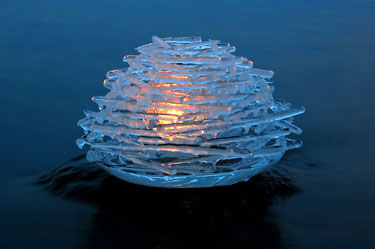
Art by Sally Smith.
Why? Because generally we do not invest this kind of effort into our day-to-day relationships. In truth, we probably don’t come anywhere close.
It’s recognized in the world of therapy that the desperate need to be understood — the primary need for someone to listen and to listen well — is at the root of widespread unhappiness. The unvarnished truth, sadly, is that to bask in such total attentiveness one has to pay for it. Like prostitution, the one-way street fills a genuine need but is artificial. It’s not “real life”. Furthermore, the experience is so intense that it has to be limited to the “therapeutic hour” of 50 minutes at a time. This is why client work can, if overdone, be exhausting — for the yawn-suppressing therapist.
As any working astrologer or therapist will acknowledge, the success of a consultation rests heavily on the act of effortful listening. Mercury, retreating through the mute dark waters of Scorpio as I write, reminds us that in this analytical process we are not listening just to what is actually said, we are also listening between the lines. Sometimes we are listening mostly to what is not being said, attempting to dredge up the precious silt from the teeming riverbed of the unconscious.
How Does the Astrologer Listen?
The worlds of therapy and astrology overlap, as a consultation is not just about the horoscope as an objective exercise. The coming together of astrologer, client and chart makes for a dynamic trio, pulling a reading into other realms and nearly always into the world of therapy. You will of course get the occasional genuine “I’m just interested” client, but they’re rare. This puts the astrologer in the rather tricky position of taking up the role of temporary therapist and, while the world of psychotherapy can manage very nicely thank you without any input from astrology, the same cannot be said the other way around.
Stay with me. This is where it gets interesting. One of the main things that distinguishes the astrologer from the therapist is the time factor. In therapy there are repeat appointments, usually over a very long period of time, during which the client will “unpack” their own personal issues at their own pace. With astrological work there may be a second or even third appointment, but there are many “one-off” consultations and the astrologer does not have the luxury of being able to return to a key point at a later date. However, the astrologer does have something that the therapist doesn’t — the horoscope.
The counseling astrologer has, therefore, to develop a highly specialized kind of listening. To grasp the astrological advantage of zooming in on a symbol as it comes into play we are not just listening to the client, we’re listening to the planets, too. We’re constantly converting the client’s words into another language, that of astrological symbolism. Much of this conversion goes on in the astrologer’s head and does not need to be spoken out loud in terms of explaining the actual astrology, a misguided attempt that only ever generates one mystified question, “What does that mean?” It pays not to lose sight of the fact that the majority of clients won’t even remember the sign of their Moon or Ascendant at a later date as it doesn’t have the same fascination or meaning for them as it does for the astrologer. They are less interested in the astrology than they are in what the astrologer has to say.
Breaking the Rules of Therapy
Only when the astrologer, client and horoscope come together can astrological information then be translated into meaning. It is the astrologer’s task to hold all the threads of informing, illustrating, interpreting, counseling and — oh yes — predicting, as the consultation unfolds. It’s also the astrologer’s job to keep the reading moving. If you’ve done any consulting no doubt you’ll have experienced the client who quickly shows every sign of settling in for the afternoon. This is in no small part due to the treat of a captive audience — someone to listen to them.
However, this begs the question: can you listen too deeply or for too long? Even with the best will in the world most people’s concentration will start to waver after listening to someone for more than 15 minutes. The astrologer, for the sake of uncovering the point of the reading and getting the message across in the allotted time must, perforce, know how to interrupt.
Conversely, I know that some astrologers like to start by doing most of the talking themselves but holding forth is a risky move, one that can alienate your client and block interaction. I personally prefer to get the conversation going as quickly as possible. The client always speaks their chart and, as long as you are fluent in astrological symbolism and able to locate their story in the horoscope, their words will always guide you to what is important.
In terms of how to interrupt, the important thing is not to talk over the client so that you both end up fighting for the same airspace. If you really are faced with a full flood of painful outpourings simple body language is often the best. Choose a suitable pause and stem the flow with a light touch on the arm, firm but kind eye contact, and a reminder as to why they are with you — for you to give them your findings. “Let me elaborate a little on how this is showing in your chart, because I think it might help you to make more sense of what’s going on, and for how long.” Often if I’m approaching the end of the reading I’ll say, “Well, we have another ten minutes, is there anything in particular you’d like me to recap or focus on?”
Being a careful interpreter – and interrupter – means that we must feel our way through each individual reading, picking up on what to translate and what not to, where we should expand and where we should abbreviate. All of this involves keeping your client engaged and listening to you, as much as they expect you to listen to them. Simple visuals of any kind will assist the effort of listening and understanding. I often sketch as I go along, such as simply drawing a circle with the horizontal line across it to show the Ascendant-Descendant when talking about relationships, or a planet on a dotted line to show a transit.
I also always work with some past transits or progressions first, rather than current or future. This establishes the client’s confidence in the astrology as well as in you as their astrologer, and there is no more effective way of capturing someone’s serious attention than demonstrating how their chart has already been accurate in terms of reflecting their individual life changes or events.
So, the ideal consultation is, in my view, a dialogue and not a monologue, and the listening/talking ratio is therefore different from the psychotherapist/client dynamic. In both, however, there is always a place for knowing when we should simply shut up and let the client talk. This can make a crucial difference to the success of a reading. Whether the conversation flows naturally, or whether the astrologer is constantly having to find ways to interject, the aim is to talk “with” the client and not “at”. It is a unique relationship that somehow exists in that twilight world between the therapist’s couch and the psychic’s crystal ball. Listen well — and the cosmos listens straight back.
About the author
Joanna Watters is a full-time practicing astrologer and tarot reader. She has practiced in London, Cairo and now in Greece on the island of Lefkada in the Ionian, where she has lived since May 1995. She started her own company in 2002, The Greek Island Summer School. She is the author of Tarot for Today and Astrology for Today. These books have now been translated into ten languages and are available in 14 different countries. You can find out more about Joanna on www.joannawatters.com
Posted in Featured Articles
Leave a comment
In Praise of Trees
This article originally appeared in the May 4, 2012 subscriber edition of Planet Waves. We are including it here as a fabulous astrology resource and as an example of the wonderful work we produce here at Planet Waves. If you are interested receiving weekly subscription mailings from us, visit this link to subscribe.
Dear Friend and Reader:
We’re approaching one of the most impressive Full Moons of the year — the Scorpio Full Moon, which this year happens Saturday, May 5 at 11:35 pm EDT. Presently the Sun is at the sensitive balancing point of the season, located halfway between (Northern Hemisphere) spring equinox and summer solstice. This time of year is known as Beltane, though in our particular year, the Moon comes along and makes an exact opposition to the Sun. What we get is a peak in the solar cycle (the seasons) coinciding with a solar-lunar cycle (the Full Moon), which is unusual and which carries a lot of momentum with it. It’s also a Full Moon at perigee — the closest point to the Earth, so visually it’s going to be a big one.

Flourish by Charlie Lemay.
Taurus and Scorpio are zodiac signs that specifically address the subject of resources, and the exchange of resources, whether you’re speaking of the planet itself, what humans exchange in commerce, through sex or in genetic material, and by extension, the economy that gathers around all of this activity.
We had a similar event on May 5, 2008, when there was a New Moon on Beltane, in the midst of a rather eventful year when we got a big reminder about our shared resources. At that time, there was something brewing that was quaintly referred to as the “subprime mortgage crisis.” A lot of banks, sucking cheap money out of the Federal Reserve Bank, had provided easy credit to many people who could not pay the mortgages back. The availability of cash was like throwing kerosene on the fire of American greed, and many people bought lavish homes though they could not afford them.
The lenders took millions of those bad mortgages, bundled them together and sold them as securities, that is to say, as “investments” made by other banks, companies and governments — but they were worth nothing. These entities were sitting on a cosmic-scale garbage dump of rotten paper — which meant that as a result, the entire economy was sitting on quicksand. Some institutions had half their total portfolio in these “products.”
This situation led to the bursting of the housing bubble — the absurd inflation of housing costs that seems to have been going on since the 1980s — followed by widespread liquidity problems that rippled throughout the global economy. The financial sector and indeed nearly every industry was reaping the benefits of its philosophy of globalism. We learned fast that what happened to one entity could affect any other entity.
The problems came to the surface undeniably on Wednesday, Sept. 10, 2008, when Lehman Brothers announced a third-quarter loss of nearly $5 billion (in one fiscal quarter). By that Sunday, Lehman had filed for Chapter 11 bankruptcy and what we now call the Great Recession was underway. Many banks were in crisis, over-leveraged and with no available cash to lend one another or anyone else. Trillions of dollars in bailouts, generated from debt charged to the citizens of the United States, were given to many financial institutions and AIG, one of the world’s largest insurance companies. This was the “financial 9-11” at the bitter end of the Cheney-Bush administration: the biggest bank robbery in history.

Ceremony by Charlie Lemay.
The astrological upshot is that there was a New Moon preceding this on May 5, 2008, with the Sun exactly at the midpoint of Taurus. I kept looking at that chart knowing it might be big, but I didn’t understand why. It seemed significant that there was a New Moon on Beltane, a holiday associated with honoring the only true material wealth, which is the abundance of the Earth.
Yet in the technical sense there’s something else significant about this point in the calendar. Events that occur with the Sun at the midpoint of any season create what is called an Aries Point effect, where there is often high-impact news of some kind that resonates on a deeply personal level with many people. The effect is not always instantaneous (though sometimes it is).
For background, the Aries Point is the first degree of Aries (the position of the Sun at the spring equinox), and by extension the first degrees of any of the cardinal signs (Cancer, Libra or Capricorn as well), which form a cross. Each time a new season begins, the Sun touches a point of the cross. These are called the quarter days, also known as equinoxes and solstices.
When you bisect those points, you land in the middle of the fixed signs (Taurus, Leo, Scorpio, Aquarius). Those are called the cross-quarter days. They are sensitive spots which can energize the Aries Point, and point to events with far-reaching effects. Notably, almost all holidays are concentrated around the quarter days or the cross-quarter days.
This is where we are now. On Saturday, the Sun arrives in the same position as it was in 2008, four years to the day later. But just as the Sun reaches the midpoint of the season, the Moon comes along and makes an opposition to it (the Scorpio Full Moon).
We are once again in an election year. And, once again the world is on the brink of what we might politely call a financial threshold, though this time the problem seems to be centered in Europe. Spain just had its bond rating downgraded two notches from A to BBB+, and the Netherlands is on the brink of losing its AAA rating. Yannis Palaiologos, an author at Prospect.org, writes that, “This would lead to a rise in the cost of borrowing not only for the country but also for the EFSF, Europe’s rescue fund, which depends on guarantees from the dwindling number of AAA-rated Eurozone members for its high credit rating.”

Something Fishy by Charlie Lemay.
On Sunday, France seems poised to elect a socialist president. This would mean someone in office who is not as friendly to German president Angela Merkel as Nicolas Sarkozy, the current president, has been. Sarkozy has in effect been allowing Germany to run the finances of Europe through the debt crisis.
On the same day there are parliamentary elections in Greece, expected to inject far-right and far-left influences into the political environment (some “sick puppies,” in the words of our Athens correspondent). This would break up the two-party system there and could alienate crisis-besieged Greece from the Eurozone.
Meanwhile in the United States, Republicans are campaigning on a platform of cuts to social programs, increased taxes on the poor and reductions in the size of the federal workforce, ostensibly to help the economy — but which are certain to have the opposite effect. They’re also waging war on women, immigrants and anyone whose sexual orientation differs from what they claim theirs to be. Given this, it’s really weird to hear predictions of a close race.
And, into this mix, we are adding the Full Moon right at the midpoint of the Sun’s transit through Taurus. This is of course influencing us in personal ways as well. Other astrology suggests that many people are making decisions about, or are in crisis over, their most intimate relationships. This has been brewing for a while, though much of what was swept under the rug is coming out, sometimes with passion, urgency and decisiveness.
Remember that we’re in the spring of 2012 — from here on out, the large-scale events increase in frequency, with the Uranus-Pluto square ever in the background, running high-voltage current through the Aries Point. We’re just weeks away from a series of eclipses and one month from the transit of Venus. Speaking of: Venus is an influence directly related to Taurus, to earthly resources, to wealth and to value. The transit of Venus on June 5 describes a kind of revaluation, or at the least a rather deep and sweeping re-evaluation.
Instead of using astrology to be predictive about these events (it’s tempting, and many will be tempted to be negative, basing their future predictions on what’s happened in the past) I think we need to be visionary. No matter what goes wrong on the planet, or what messed-up things people do, it’s people who solve the problems and people more connected to life who invent new ways of life. Eventually over time, there seems to be very slow progress. Yet we are now at a quantum point. The combined creative intentions of even a few people can be magnified by the rapidly rising energy — which brings me to trees.
The economy as we think of it is a study in exchange, but it seems to me that the real exchange on our planet involves trees. This is true in the biological sense of the word, and economic (most people live inside houses made from wood) though trees are sentient entities, many of them centuries (or millennia) old that ground profound information onto the planet.
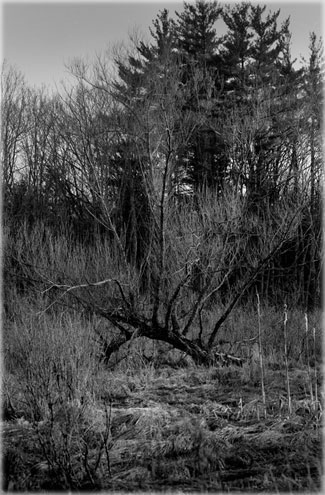
Renewal by Charlie Lemay.
Despite its reputation for frisky erotic play among neo-Pagans, Beltane is really a tree holiday. That’s the theme that many related holidays around the world at this time of year share — a celebration of trees. “This is Spring Growth Mother Earth Green Day,” says Donna Henes, author of Celestially Auspicious Occasions, who was my guest this week on Planet Waves FM.
“The spring cross-quarter day is all about growth. Spring equinox is about birth, and the mid-spring cross quarter day is about the exuberant, vibrant, hormonal kind of growth. That’s the link between the tree and the sexual frenzy that we associate with the May Pole. It’s a celebration of the new green, the growth of life, of life on Earth and Mother Earth, the Creatrix. The tree is a universal symbol of life, from Buddha being born, receiving enlightenment and dying under the tree, and on and on.”
The tree is celebrated as an entity that reaches deep into the ground and at the same time reaches to the heavens. It is a bridge between Heaven and Earth, with its growth nourished both by the light of a star (the Sun) and the solid mass of the planet where it has its roots.
In Pagan times, this was celebrated many ways, including with the May Pole dance. The pole is of course made from the trunk of a tree that is draped in garlands, to which are attached long ribbons. The dance involves everyone holding one of the ribbons and then weaving the web of life, circling the pole in an obvious celebration of the phallus. But there’s a lot more going on as well.
The Catholics adopted the May Pole celebration into Holy Cross Day, celebrated May 3, a Catholic version where they turn the tree into a cross (the Catholics have versions of all the Pagan holidays), which is a bigger deal in South America. “Throughout Latin America, they celebrate it as Cruzelacu, in midspring, which is a nature appreciation holiday. A cross is decorated as the May Pole would be, with ribbons and flowers, and sometimes flags, jewelry and dresses,” said Henes.
In the 1640s, there was an act of the British Parliament banning the May Pole. The law assailed the “heathenish, vanity, generally abused to superstition and wickedness” of the dance. The Restoration brought back May Poles, and there was a huge one erected in The Strand in 1661, which required the strength of 12 soldiers under the personal supervision of King James II. This was a 134-foot cedar pole. Then in 1717, it was moved to Wanstead Park in Essex, where it became part of the support of Sir Isaac Newton’s telescope.

Pas de Deux by Charlie Lemay.
“It was still serving the original symbolism of the tree, which is rooted in the ground and reaching into the heavens,” said Henes.
In contemporary Brazil, May Day is celebrated by designating a particularly powerful tree and decorating it with white flags.
The Liberty tree is a common symbol for several North American tribes. In the late 1800s a movement began to unite the tribes and present a common front to expel the white man. They created a ritual called the Ghost Dance where they circled around what they called the World Tree.
There’s also a Jewish holiday called Tu B’Shvat, which celebrates the birthday of the trees. In contemporary times, funds are raised and trees are purchased and planted. It’s a national tree-planting holiday in Israel, which has a national obsession with re-planting the desert.
On the other side of the world, there is a Chinese festival called Ching Ming, or the Bright and Clear Festival, where graves are cleaned and trees are planted near the resting places of the ancestors.
Finally, there’s a worldwide holiday that you hardly hear about any more called Arbor Day. On the first Arbor Day, held in Nebraska on April 10, 1872, an estimated one million trees were planted.
That’s a good thing — trees do nothing but support life on Earth. They are integral to the biosphere. Without them, life on Earth would not only collapse — we would all be a lot dumber than we already are. Researching the biological themes, I spent some time on the North Carolina State University website yesterday and this is some of what I learned.
One large tree can provide a supply of oxygen for two people. At the same time, a tree can absorb as much as 48 pounds of carbon dioxide per year, and can sequester one ton of carbon dioxide by the time it reaches 40 years old.
Forests supply over 50% of freshwater flow in the lower 48 states. According to USDA Forest Service estimates, some 180 million people — more than half of the United States’ population — depend on forests for their drinking water.

Wall by Charlie Lemay.
In addition to providing oxygen and water, trees keep the air breathable. Over one year, an acre of forest can consume the amount of carbon dioxide created by driving a car 26,000 miles, about twice the annual mileage for an average driver. An acre is pretty large. It’s a good thing that in the U.S., forests cover 749 million acres. That’s nearly 33% of the nation’s land. When the United States was first settled, they covered 46% of the nation’s total land area.
We would be in a symbiotic relationship with trees, were we not chopping them down so fast. Symbiotic means both parties to the equation benefit from the relationship — and trees do benefit from our presence and offer themselves to us for many purposes. At the moment, we seem to be getting most of the benefits of trees, but we also seem to be missing a larger point.
There’s a dimension to trees that some people have encountered and others have devoted their lives to. One such person is Elisa Novick, who you may have already encountered in a recent edition of Planet Waves FM. Elisa reminds me of an other-worldly cosmic entity that I might have met in a science fiction novel, except that she’s a real person working as a healer on the planet. Here is how she tells the story of her first meeting with a tree in a forest in upstate New York, not far from where I live.
“Walking down a mossy forest path, I was met by a powerful wave of love emanating from a magnificent oak. So began a fascinating multidimensional odyssey spanning 10 years, as a small patch of forest became my happiest place in the universe and a place for healing and awakening for many,” Elisa wrote in an email to me yesterday.
“Each tree has a unique personality and gifts to bestow. Trees hold keys for the survival and thriving of the Earth. They created the conditions for us to live on this planet and can do so again if we ally with them.

X Chromosome by Charlie Lemay.
“Learn to receive their healing love and converse with them and support them in their mission. Let’s not assume that if our ears can’t hear, that there is nothing spoken. Attunement is the next language of communication — with people, plants, animals, and the cosmos.
“My hope is that if more people understand that trees can be sentient and have healing and spiritual abilities beyond anything we have imagined, we will nourish those that are still alive and replant our bountiful forests. Not only the other half of our lungs, they may be the other half of our hearts.”
Elisa has the ability to communicate with entities that don’t use what we consider the normal senses. Here is what an oak tree in that forest said to her:
“In another world we were lovers, you and I, in dimensions too difficult to describe, but all things come around and we are brought together for a reason when it is correct and useful. Now this planet is dissolving in pollution and all are suffering to some extent. But there is always renewal available. You have renewed our context here on this planet by your thoughts and good wishes and we wish to stay now; though we have scouts foraging for another wilderness to ‘set up shop’.
“We are always prepared, as your Scouts say. Funny that you should mention contingency plans at your breakfast today. But in this spiritual realm, there are no contingency plans, no plans, just the unfolding of a reality that is long known, but never planned. How can I say that this is true? Or how to be fortunate enough to be enlightened/privy to this information? The known comes forth as it reveals itself out of the Great Plan, but it is never planned ahead of time; just revealed in its true glory, fully formed. Then it develops by choice, will, playful endeavor; curiosity; happiness. It is creativity in this making, Universal, powerful urges move through all, causing creativity to flourish in response, like leaves to the sun and wind forces. We move, too, we trees, as we are called by the greater plan, but have many choices and happiness rules the moment as to when and where we plop ourselves down and give of our happiness to the Earth or other spaces.”
A maple tree said:
“Many of your species have noticed that we (trees) are not doing as well as we used to; our leaves are dying from your poisons and our roots are also feeling the pinch. The water is no longer fully wholesome from soil or sky and we don’t like noise that is unnatural and vibrates our roots badly. But we continue to pour forth love and healing chemicals and go about our nature/natural lives in pursuit of a ‘higher ground’, a place wherein we become greater selves. Our development spiritually and consciously is all-important. As we develop, we develop new abilities and can bring forth great wonders energetically and also to the physical manifestation.
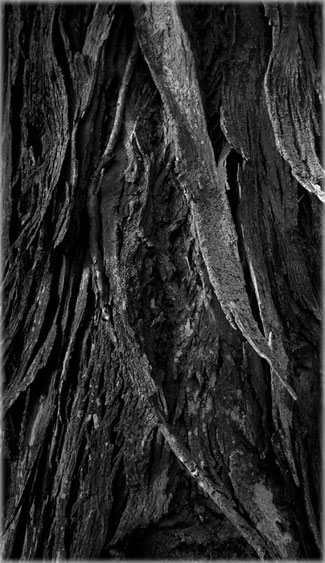
Revealed by Charlie Lemay.
“Call us forth. Please don’t deny yourselves this ability to call forth nature’s finest consciousness, its abilities to heal itself and the world. This garden planet is unique in its resources for higher consciousness and verdant growth possiblities. It provides great stamina and strength to its species and has an integration unlike any found. It can sustain great damage and heal itself, but it cannot sustain continued or even sporadic damaging; conscious and unconscious.
“So be well my friends. Come forth in your glory and you will find us waiting in glory to welcome you and live in harmony and grace (yes we know grace; we form it every day); we exude this natural grace. Solemnity is not part of that, but laughter, playfulness, ease and lightness of being; we are creative and naturally curious and we love the Christ consciousness coming through every pore of this planet’s existence. It is what the planet is made of after all. You must broaden your idea of what it is; your ideas are so narrow and limited. Widen and enlarge your awareness and you will find Me (Christ) in every cell of every plant and every stone and every being that exists, animal, dolphin, whale, etc.”
You can read more of these messages in this PDF that Elisa has prepared for Planet Waves readers.
The author Hermann Hesse seemed to be onto the inner life of trees as well. “Trees are sanctuaries,” he wrote in his book Wandering. “Whoever knows how to speak to them, whoever knows how to listen to them, can learn the truth. They do not preach learning and precepts, they preach undeterred by particulars, the ancient law of life.
“A tree says: A kernel is hidden in me, a spark, a thought. I am life from eternal life. The attempt and the risk that the eternal mother took with me is unique, unique the form and veins of my skin, unique the smallest play of leaves in my branches and the smallest scar on my bark. I was made to form and reveal the eternal in my smallest special detail. A tree says: My strength is trust…I trust that God is in me. I trust that my labour is holy. Out of this trust I live.”
Lovingly,
Posted in 2013 Resources Area
Leave a comment
Cue: Be One (or The Kuiper Belt Turns 20)
This article originally appeared in the August 31, 2012 subscriber edition of Planet Waves. We are including it here as a fabulous astrology resource and as an example of the wonderful work we produce here at Planet Waves. If you are interested receiving weekly subscription mailings from us, visit this link to subscribe.
Dear Friend and Reader:
Astrology is based on the premise that the shape of the solar system reflects the shape of consciousness. If that’s true, the edge of the solar system would represent a boundary or edge within the psyche, a place where familiar territory ends and the unfamiliar begins. Over the years, this boundary has moved gradually outward. For as far back as anyone was looking at the sky, the boundary was Saturn, the most distant visible planet. The edge moved outward with the first discovery of a planet — Uranus, in 1781, and with that discovery, the age of science and industry had officially begun.

Illustration of the Kuiper Belt by Don Dixon, which originally appeared in Scientific American in 2000. The outermost inner ring is the orbit of Neptune. The inclined orbit would be something like Pluto, though with a much longer orbit than Pluto actually has; in 2000 it would represent a possible discovery, though the shape and inclination are evocative of Eris. The Kuiper Belt is the cloud of small objects that surround the solar system. © by Don Dixon, all rights reserved.
Next came Neptune, which was finally observed to be a planet in 1846. Neptune for its part was a strange discovery — Galileo was the first to see it, way back in 1612, though neither he nor numerous astronomers who followed him actually understood what it was, even though they noticed it was moving. Such is the elusive nature of Neptune.
After its discovery in 1930, Pluto was the furthest known object orbiting the Sun. It was discovered by accident, when astronomers were busy looking for something much larger, something they’ve yet to find.
Over the years, different astronomers had theorized that there were swarms of small objects beyond Neptune, though by 1992, only Pluto had been found. Most astronomers accepted that it was the outer edge of the solar system. There didn’t seem to be a lot of interest in searching, either. There was no grant money available for the project; it was not as glamorous as studying the known planets. At that time, a lot of attention and resources were going into the Cassini mission to Jupiter and Saturn, as well as to Hubble space telescope projects that involved gazing out to the edge of the universe.
Jane X. Luu, then 29 years old, was doing postdoctoral work in astrophysics, collaborating with Prof. David Jewitt at the University of Hawaii’s observatory on Mauna Kea, Hawaii. They were researching small objects in our solar system, such as comets and asteroids. (One theory about this possible new region of space was that it served as a reservoir of comets.)
They had a question: why did space beyond Pluto seem so empty? In the true spirit of science — curiosity — they decided to look around.
“To us it was of scientific interest,” Luu recalled in an interview last week. “In terms of prestige, we had never wanted to study any planet. Grants are easy. Why study something that lots of other people study? We were going to do things that nobody else wanted to do.”
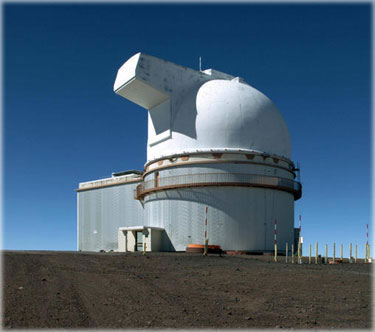
The 2.2-meter telescope at Mauna Kea, University of Hawaii, where 1992 QB1 and the Kuiper Belt were discovered by Drs. Jewitt and Luu. Photo from the University of Hawaii.
So, they spent their time peering off into the edge of the solar system, looking for anything that was moving. Mauna Kea is an ideal ground-based observatory because it’s sitting on top of a dormant volcanic mountain 4,200 meters above sea level, where the skies are often clear, and where there’s minimal light pollution or smog. Plus, it’s a smooth mountain, so there’s relatively little atmospheric turbulence — the bane of astronomers everywhere. They were using the University of Hawaii’s 2.2-meter telescope, a dependable old beast that had been in operation since 1970.
On the night of Sunday, Aug. 30, 1992, just before 11 pm local time, they pointed the telescope toward the southeastern skies and focused on a faint object. In fact it was so faint, it’s amazing they saw it against the backdrop of the stars. Over the next 90 minutes, watching on a monitor connected to a digital image captor, they noticed that the object was moving — which meant that it wasn’t a fixed star.
Jewitt and Luu had discovered the first-known object orbiting our Sun beyond Pluto. After 62 years of being the presumed edge of the solar system, Pluto’s reign was very quietly over. However, it would take a long time for the news to spread. The object they discovered was not especially large, and these particular astronomers are not media hounds.
The discovery was given the provisional designation 1992 QB1 — a technical reference that notes when it was discovered, and that it was the 27th object found in the second half of August of that year, nearly all of them asteroids of various kinds. (The second centaur planet, Pholus, had been discovered earlier that year, and the third, Nessus, would not be discovered till 1993. Centaurs are small planets located inside the orbit of Neptune.)
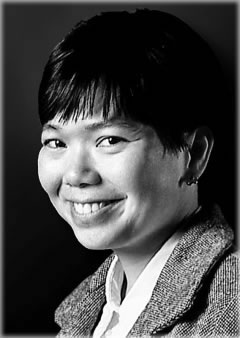
Dr. Jane X. Luu, astrophysicist and co-discoverer of the Kuiper Belt, now a senior scientist at the Massachusetts Institute of Technology. Official photo.
1992 QB1 has a nearly perfect circular orbit, which means it’s very stable. (The stability of its orbit is evidence that this region of space is not the origin of comets — they probably come from a region further away.) QB1’s orbit is nearly parallel to the solar equator, which takes it around the Sun in just over 289 years. That’s about 39 years longer than Pluto takes to orbit, though Pluto has a wildly elongated path, which meets the plane of the solar system on a steep angle.
Because it was beyond Pluto, 1992 QB1 was also the discovery of what became known as the Kuiper Belt, named (or misnamed) for Dutch astronomer Gerard Kuiper. QB1 was the observation that demonstrated that there are indeed objects beyond Pluto within our solar system. If there was one, there would be more. There are about 1,000 known today, and Jewitt has predicted that there are as many as 70,000 — probably a conservative estimate based on an actual calculation.
Imagine the Kuiper Belt as a plane extending into space, similar to a ring of Saturn, though surrounding the Sun, out beyond all the larger planets. The discovery represented a radical step in the understanding of the solar system, though its significance isn’t fully appreciated. Among astronomers, many other discoveries get more attention (Eris, for example). Studying these small bits of planetary matter give us a glimpse into the early history of the solar system.
Among astrologers, 1992 QB1 seems to get the least attention of any minor planet. This is in part because the minor planets are not a popular topic in astrology, and even among astrologers who specialize in the new discoveries, QB1 leaves most of them without a starting point because it doesn’t have a name. The names of newly discovered planets almost always come from the astronomers (who don’t generally ‘believe in’ astrology, or think about it much). Yet astrologers depend on these names to help them suss out the meaning a new planet might contain.
Jewitt and Luu had proposed the name Smiley, after the fictional character George Smiley in the spy novels of John le Carré. Smiley is a kind of anti-James Bond — a quiet, disciplined espionage agent rather than one always running around with his gun drawn. But the name had been used on a main-belt asteroid honoring Charles H. Smiley (1903-1977), who was chairman of astronomy at Brown University. Jewitt and Luu did not propose another name, and they have no plans to.
When other bodies were discovered with orbits similar to QB1, they started to become known as the cubewanos, a pun on Q-B-1-ohs. This is some insurance that 1992 QB1 will always be its name. Once its orbit was confirmed and it got a place in the Minor Planet Catalog, its proper name became (15760) 1992 QB1. This always reminds me of Asteroid B-612 from The Little Prince.

David Jewitt, co-discoverer of 1992 QB1 and the Kuiper Belt, now a professor at UCLA. Official photo.
Last week I asked Jane Luu if she would share some impressions about her now-famous discovery.
“A lot of people don’t like it, because it started all the trouble for Pluto,” she said. The discovery of QB1 led to many other astronomers looking for objects in the Kuiper Belt, and one of them — Eris, discovered in 2005 — led to Pluto being reclassified as a Kuiper Belt object. “They should think of it as a new frontier of our solar system. It’s just like exploration way back in the 1500s. It’s about mapping new worlds.”
I asked how they financed the project. “We did it by lying and stealing, the usual way things are done,” she said. “We didn’t get any money for it. We would get telescope time to do other projects, and we would use it to do this. We’re good astronomers; we publish a lot and we’re productive, so nobody could accuse us of wasting resources.”
The region of space that Jewitt and Luu discovered was named for Gerard Kuiper (1905-1973), who in his writings referenced the possibility of a swarm of objects in the outer solar system.
“Kuiper anti-predicted the Kuiper Belt,” Luu explained. “He said it would be gone by now. It’s near Pluto and he thought that Pluto was going to scatter everything away. It was all conjecture. He had no numbers to back up anything. He was just guessing.”
It seems ironic that someone who predicted that something would not exist got that thing named after him. “Most people would be happy,” Luu said. “He got something for nothing.”

Four original photographs that led to the discovery of 1992 QB1. The images show the object moving slowly westward through the sky, indicated by an arrow.
To correct this, it’s sometimes called the Edgeworth-Kuiper Belt (or in England, the Edgeworth Belt, though you rarely hear this), adding the name of Kenneth Edgeworth, an Irish astronomer, economist and engineer. In the 1940s, he proposed that there would be a disc of icy bodies beyond the orbit of Neptune. “Edgeworth was obscure,” Luu said, “but he did not anti-predict it, like Kuiper.”
Why wasn’t the Kuiper Belt discovered sooner? It took 62 years from the discovery of Pluto, during a phase of history with increasingly spectacular telescopes. “These things were always out there, but people didn’t look for them,” Luu said. “People are not good at finding things they don’t expect to see. What you look for you will find. But sometimes it takes a bit longer than you expect, if it exists.”
Now, many of the most interesting new discoveries are found in the Kuiper Belt. Some are more of the nature of Pluto (called plutinos, with orbits around 250 years) and many others are of the nature of QB1 (the cubewanos, or classical Kuiper objects, with orbits closer to 290 years or longer). Plutinos are named for underworld deities. One example is Orcus, named for an Etruscan [ancient Italian, pre-European] underworld god who predates Pluto. Cubewanos are named for deities associated with creation and resurrection (Quaoar, a Native American creator god, is an example). There are other categories, which are sorted by how many orbits the smaller planet makes compared to Neptune. For example, Plutinos orbit twice for every time Neptune orbits three times. There are other categories with other resonances to Neptune.
Whatever the math involved, David Jewitt and Jane Luu proved one thing: that space is not empty beyond Pluto; there’s something there. For astrologers, so invested in what these things mean symbolically, this is rich territory. Or it should be, anyway. Most people’s consciousness stops at Pluto, if it even gets there, which is a significant limit, given the level of fear involved. One irony is that many astrologers don’t believe in the minor planets. Yet the discovery of QB1 led directly to the reclassification of Pluto as a minor planet, complete with a minor planet catalog number — now known as (134340) Pluto.
Beyond Pluto — Beyond the Edge
I’ve been developing my own impressions of QB1 since 1998, when I was given an ephemeris by centaur specialist Robert von Heeren, who I met when I was living in Munich. He didn’t share any ideas about QB1, just a folder with a stack of printed pages that contained the ephemeris he had calculated himself. [You can see Tracy Delaney’s version here, on Serennu.com.]

Pluto, illustrated by John Smith in 1709. He is shown kidnapping Persephone. Pluto is usually depicted naked and wearing a crown or helmet; the helmet makes him invisible to those he’s about to take.
For me it was news enough that something existed outside the orbit of Pluto. So let’s start there, since it’s a reference point. Each time a planet is discovered beyond something that’s been the long-established edge of the solar system, we experience a paradigm shift, both in our understanding of the planets, and how they work astrologically. History turns a corner. There also seems to be an extension of the presumed limit on human potential.
Mythologically, Pluto is the Roman god of the underworld. His temples were rarely visited by anyone; he was not a popular figure. As the lord of death, he was portrayed as a kidnapper, who traveled under a cloak of invisibility, a power granted by his helmet.
Astrology usually associates Pluto with the topic of “death and transformation.” Many would consider this a polite statement. Everyone who has lived through a Pluto transit consciously knows that they can be challenging. Indeed, they can be devastating, though we become deeper, more soulful people. As minor planet specialist Martha Lang-Wescott has said, we often miss Pluto transits when they’re over.
In history, I associate Pluto with what I call the Death Works era. The mechanized, chemical-infused death orgy known as World War I preceded the discovery of Pluto by about 16 years, though once Pluto was discovered, things really got cooking. Hitler came to power just three years later and turned genocide into an industrial process. When he was done, Stalin took over and outdid him with the gulag system and many, many more murders.
The rest of the 20th century was pretty much one long war; just naming a few, there was Korea, Vietnam, Cambodia and then Pol Pot’s genocide; there was the “Cultural Revolution” in China (the wide-scale enforcement of orthodox communism); there was a long massacre in Central America and a simultaneous one in East Timor; there were the genocides in the Balkans, there was Bush War I, and an ongoing, seemingly endless war in Africa. The 21st century began with the Sept. 11 incident, which was used to propagate wars in Afghanistan and Iraq. As Noam Chomsky wrote in The Culture of Terrorism, the way to impress Congress is to show them how many people you’ve killed; then you get funding to kill some more.
I don’t blame Pluto for this, though I think that Pluto represented for many people a limit on their consciousness. The limit involved (and for many still involves) the idea that death is the ultimate power, and could be used to get anything, or to gain any advantage. In this toxic belief system, death is the end, it’s the scariest thing, and whoever wields it can feel like God, or at least a god (and not such a creative one) for a while. Death and all the anxiety around it are often substitutes for sex, for love and for a conscious, willing sense of transition. Pluto can represent obsessive forces, and one manifestation is an obsession with death.
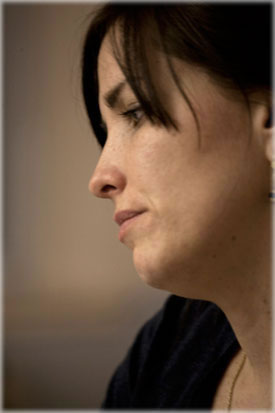
Annalee Orsulich is a doula, who assists both the midwife and the birthing mom in the birthing process. Though it’s being mechanized by medicine, in truth childbirth is an unpredictable experience every time it happens; some of a woman’s worst fears and inhibitions can come up during a birth, as well as her greatest strengths — and it takes someone special to hold space for that. Photo by Eric Francis.
Psychologically healthier people have a more functional relationship to change, and to growth, other themes that Pluto represents. Yet even for them, the shadow side of Pluto can be frightening, because it involves investigating the spaces in ourselves that we’re taught to deny, and to be terrified of. Then gradually we integrate the fear of change, and the changes themselves. Through this process we evolve; we can learn to center ourselves in soul consciousness. Yet most people go kicking and screaming.
There has to be a better way. Chiron, discovered in 1977, did a good job of beginning that conversation of a better way; it was the first planet ever discovered that became associated specifically with the healing process. Chiron is also associated with holistic consciousness. Chiron, the “inconvenient benefic,” is gentler than Pluto, and it’s more consciously associated with healing and transformation rather than death and transformation.
Power in the style of Chiron is what you gain from going through your challenges consciously, and what you gradually accumulate as you address your sense of wounding, and develop the power to heal yourself (and possibly assist others). The gradual development of Chiron as an astrological tool was a big step on the way to what 1992 QB1 represents, which is a conscious, preferably willing, process of change. Chiron has taught us a lot about Pluto, and I think 1992 QB1 will have a similar role.
Researching the earliest notes I have on 1992 QB1, I found this comment in an article called Worlds Beyond Neptune, published on Planet Waves in 2003: “QB1 may have associations with the Phoenix-like process of arising into new incarnations within our current lifetime, which often happens as a result of near-death experiences or with the experience of ‘ego death’.”
There’s a lot here about letting go of fear, which is part of every healing process. QB1 shows us that there’s something on the other side of what we’re afraid of, and of the fear itself. Our prior model of the solar system seemed to be saying that there was nothing on the other side of Pluto, of death; last stop, game over.
When Pluto later came to represent what some astrologers call evolutionary process, its reputation improved slightly, though it still seemed to stand for an involuntary imperative. As many have noted, one reason why Pluto transits can seem so scary is the feeling of not knowing what’s on the other side — or fearing that nothing is there.
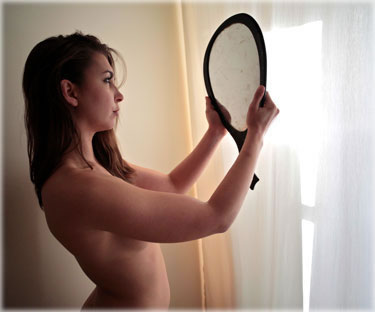
The opposite of kidnapping: self-knowledge. I associate 1992 QB1 with processes that acquaint people with themselves, so that we’re less susceptible to being taken over by others. One aspect of this is what I call “coupling,” or getting to know yourself in an unusually intimate way. Photo by Eric.
This new discovery whispered that there was more, and that it was worth letting go of the fear, and I think that QB1 shows a way of doing that. In the chart, think of it as pointing the way beyond your perceived limits about death, which remains a thought so terrifying to most people that they cannot even consider it. Now in the metaphor of the solar system, we have something in the model that says there is more; that there exists something beyond this perceived edge, which we can access if we want.
As I began to explore that idea, I began to understand QB1 as representing anyone who would help people move through processes where this kind of transformation or release was happening. I associated it with those who help people be reborn at the end of their lives — that is, an advanced kind of hospice work. There are some practitioners actually doing this now — though the work is controversial, because it defies the medical establishment, the hospice industry and the funerary industry.
Midwives as well seemed to be involved in the process of birthing new people, and taking women over the transition into a new phase of their lives, which is often like a form of reincarnation. Midwifery is a profound service, and a sacred trust. Midwives guide women through what is in truth a near-death experience, and if it goes well, a baby is born and the mother is reborn.
I was also familiar with the work of Betty Dodson, who developed what she calls orgasm coaching: consciously helping women learn to orgasm (something more necessary than you may think). I began to associate QB1 with certain kinds of sexworkers, the ones who understood that they were doing a service to humanity through their work. This came into focus during a reading for a client in Paris who had 1992 QB1 exactly in her ascendant, and who was designing an evolved form of prostitution with a focus on helping people liberate their sexuality. There’s a need in the world for well-trained sexual surrogates, who would help people past their inhibitions, phobias and fears — and there are people who very quietly do this for others.
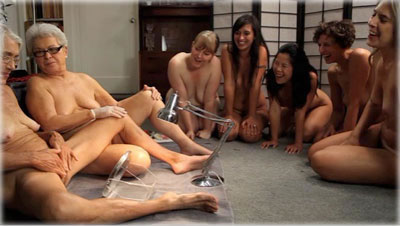
Sex educator and orgasm coach Dr. Betty Dodson (second from left) teaching one of her bodysex classes, which she’s taught since the early 1970s. Betty is what I would consider a thresholder, someone who assists others in crossing inner boundaries and inhibition, facing the fear of their own sexuality. She has worked with tens of thousands of women and has produced books and videos that have reached millions. This image is from her new video.
What all of these had in common involved taking people over a threshold, so I started to associate 1992 QB1 with the thresholder. As I developed the idea in my fictional stories, the thresholder began to emerge as someone adept in all of these methods of healing and transformation.
Their actual role is to guide people into self-awareness, which is another way of saying into relationship with themselves. I call this process coupling. This is not about coupling with another person, but rather that of becoming acquainted with, and friends with, and lovers with, the inner alien with whom we live.
These ideas meshed elegantly with a subtle, egoless (nameless) planet orbiting silently outside the realm of Pluto, off to the edge of the solar system. Thresholders show us what’s beyond the edge, taking us into new territory and introducing us to the dimension that exists there. One day Dale O’Brien, familiar with my ideas, wrote to me and said the name is obvious. 1992 QB1 is your cue to be one.
It would make sense that 1992 QB1 was discovered on the first degree of the zodiac — the Aries Point. Aries is the sign of “I am,” though the Aries Point connects us to a collective reality. Indeed, 1992 QB1 relates to experiences, fears and inevitabilities that we all have in common. We all cross the threshold of the birthing process, then we do it over and over again. Many of us do it with help; assistance really is necessary here on Earth, with all its adversity.
If we look out at the current political landscape, it’s easy to see how this core, essential human material is harvested into a commodity, used against us, sold back to us or forced on us. This can only happen if we don’t take ownership of what’s within us; if we’re afraid to encounter the edge, and lack the faith that there’s something on the other side.
This is less likely to happen with those familiar with themselves, and who have taken the step toward meeting their inner stranger, that being who lives on the other side of a psychic boundary. You could say that QB1 represents the truth that there is life beyond the body, and beyond whatever you’re going through now.
Lovingly,
Posted in 2013 Resources Area
Leave a comment
The Folk Art of Therapy
This article originally appeared in the August 17, 2012 subscriber edition of Planet Waves. We are including it here as a fabulous astrology resource and as an example of the wonderful work we produce here at Planet Waves. If you are interested receiving weekly subscription mailings from us, visit this link to subscribe.
Dear Friend and Reader:
For a few years I’ve been wanting to write an article about how to pick a therapist. I know that there are those for whom opening up a real discussion about their lives is burning in their soul. Others know they’ve been dealing with the same problems over and over for years. You may see the same patterns repeating in your relationships, your career, your family life or other aspects of existence, and you decide that it’s time for that to change.
Helping people get into therapy has been one of the themes of my astrological practice. I believe in therapy and I think that in American society, so obsessed with denial and immaturity, it’s the one thing that nearly everyone needs, if they want to grow up and be not just functional adults, but also people who live fully.
Yet till now I haven’t felt comfortable writing the article. So in the interest of good therapy, I’ll start with my hesitancy.
First issue is that I’ve heard a lot of stories of unhelpful or even hurtful experiences. I’ve had a few myself. I’m aware that there’s a lack of trust looming around the whole issue of therapy. There is also a belief that it’s superficial.
Next issue is that when most people are choosing a therapist, they are in some kind of crisis, and that’s not necessarily the best time to be making such a critical decision. Yet it’s the time that it typically happens.
Another issue is that there exist a diversity of misunderstandings about what therapy is and how it works. For many people there is the perception that it’s supposed to be a magic or at least deeply mysterious solution. Images of the patient reclined on the couch in Dr. Freud’s office come to mind; he and he alone understands the workings of their unconscious — and the old man had a lot of problems (as do many contemporary therapists, who according to Alice Miller tend to come from abusive backgrounds).
Others treat therapy as if “going to talk to someone” is the ultimate admission of weakness — they are somehow not self-sufficient or intelligent enough to live their own lives. They want to go it alone. Lurking in the background here may be the idea that “I don’t want to go talk to someone because I’ll find out something I don’t want to know” or “they’re going to tell me I’m crazy.” (Often this translates to some form of, “I don’t want to deal with my problems.”)
Despite the existence of these reservations, I’m confident that good therapy is helpful and possible, though I am skeptical of how many people are actually qualified to do it. When I consider the diversity of innate and trained skills that it’s necessary to have, and the level of ethics required, and how bad the training can be, it doesn’t seem like there will be too many qualified candidates.
When I knew that I needed therapy in my late 20s, I set just one firm guideline for who I worked with — that the person would not have a Ph.D. Twenty years later, I don’t believe that a Ph.D. is an automatic disqualification; I’ve met some fantastic psychologists who have actually earned their doctorates, and who are truly helpful, wise and compassionate souls.
Yet I can see I was onto a significant distinction: I was looking for someone who practiced the folk art of therapy, rather than the institutional or academic kind. I’ll explain the difference in a moment, with a reminder that there are people who are part of both worlds.
My reference to someone named Joe Trusso came from a guy named John, who was having a torrid affair with my then-lover Sabine. One night I went to have dinner with the two of them, and after a while John suggested that I call up Joe and talk to him. John was an illustrious (even notorious) character. I think what I may have trusted the most was that John understood something about me, and his recommendation was an outgrowth of that. I had nothing to lose by going in for a session.
Now, you probably wouldn’t ask your partner’s lover for a reference to a therapist, or to anything for that matter. However, you might get the name of someone by some means that seems unusual. A synchronicity might be involved. In truth, references are a pretty good way to get started shopping around. Ask people you trust if they have heard of anyone, and ask what they heard.
The key fact is this: however you may be feeling, you’re going to need to make an informed decision, you’re going to need to trust that decision for a while (say, for three sessions, till you have a feeling for how things are going), and then you’ll need to evaluate how you did. Even an informed decision is a roll of the dice, however there are common-sense ways you can skew the odds in your favor, which could be applied to any selection process for a healer or practitioner.
If you don’t have a reference from a friend or another practitioner to work with, then open up the local community newspaper and see who is advertising. Pay attention to how you feel reading the ad and dialing the phone.
Is the person easy to reach? If you leave a message, do they call you back fairly soon? Do they answer your questions patiently? This is more than good business practice; therapists know that people often call them when in crisis, and they know that those first few minutes are a key time to cultivate trusting communication, and to offer a prospective client the chance to feel listened to and cared about.
When you pick someone you want to have a first meeting with, you might be inclined to tell them your whole story, which would be a good sign. But sometime during that first visit (or before), make sure you ask for a copy of their CV (curriculum vitae, a long-form resume that all professionals should have available). In my opinion, you’re looking for two things on their CV — the first of which are educational and professional experiences that qualify them for the service that they are currently offering.
Second, I suggest you look for diversity of interests. When I read Joe’s CV, it included therapy training in workshop format, educational experiences, teaching, educational consulting, plus some of his artistic and scientific endeavors. Among them was the fact that he’s a musical composer, with some of his notable performances listed. The topic of his master’s thesis was the magical powers associated with the shapes of musical instruments in indigenous cultures. This impressed me as intelligent and open-minded.
I think it’s far preferable to work with someone who is excited about life, and who challenges themselves to grow and explore existence. That’s the kind of example you want — and a therapist is very much an exemplar, not of a perfect person, but of an alive one. Such a person is more likely to relate to what you say and the unusual things you might want to do, and less likely to try to fit you into a box. The essence of therapy is to bring out the person you are inside, rather than have you be someone else.
Most people will want to know the person’s credentials — you know, they went to Cornell or Harvard and have the following licenses, and that would be enough. However, whatever their credentials, I suggest you go with your feelings. Do they take an active interest in you and your life? Can you feel their empathy? What does your intuition tell you? These things are FAR more important than how many merit badges they have.
Let’s make a distinction between the academic/institutional approach and the folk approach to therapy. To the extent that therapy exists these days, much of it takes the academic/institutional approach — coming with the need to make a diagnosis, for example. Psychologists and social workers have this cryptic thing called DSM-IV, which supposedly lists everything that can possibly go wrong with a person’s mind. As the patient, you would need to fit one of those categories; your diagnosis gets a little code, and that code is used to collect insurance (for example, social anxiety disorder is DSM-IV 300.23). Some people also find it comforting to know what’s ‘wrong’ with them, at least in the theory of a psychologist.
Many practitioners who use the diagnosis model will either prescribe mood-altering drugs, or refer you to someone who will. I find it stunning, shocking and unbelievable that so many millions of people you see on the street are taking ‘anti-depressants’. In my opinion, mood-altering prescription medications are only necessary in rare cases, not for everyday depression or anxiety. There is considerable evidence that they make matters worse. And they are prescribed without actual scientific data (for example, indicating exactly what ‘chemical imbalance’ is being treated). The purported goal of this kind of therapy is to cure the patient.
Alternately, the folk art of therapy has a more down-to-earth approach. The therapy room is a place of refuge or sanctuary. That’s how it should feel when you sit down there — like a place off to the side of existence, protected from the demands of the world, and a place where you want to come back. If after the first session you feel better about your life and you want to come back, that’s a good sign. Then see how you feel after the second session. If things go well for a month or so, give the person a chance and reassess in six months. Remember that there may be ups and downs in your attitude toward the work — but that’s not a given.
In this approach, the therapist is a witness and mentor. They maintain a loving presence, though one that’s not attached to your outcome. This is the crucial difference between a friend (or lover) and a therapist: someone you’re involved with personally may have a diversity of biases and attachments to you; your therapist will see you more objectively, and when you walk out the door you’re free to live your life — and come back — without worrying about their opinion of you.
One goal of this kind of therapy is accelerated maturation. It’s also about learning about yourself through an unusual kind of relationship that can become a model for other experiences. Your therapist should be the most supportive person in your life. This will teach you what a supportive person is.
There’s a deeper layer, though. I believe that ultimately, therapy is about the cultivation of trust. That is the thing learned; the missing experience had. This is saying a lot on a planet where trust is the rarest human element, and the thing most often abused when it’s found.
There is an idea going around that ‘talk therapy’ is superficial, and can only go so far, particularly compared to ‘energy work’. Without commenting on ‘energy work’, I will say this: trust is a core issue in life. Our cynical and self-judgmental attitudes are usually based on lack of trust, and this is almost always crippling.
The therapy relationship becomes the vehicle for that experience of learning trust, not in theory but in actual practice. That takes time, though it will proceed from a point of contact. That point of contact leads to the conscious observation that your trust in someone is growing, that it exists at all, or that some benefit will come from it. The relationship becomes an active demonstration that trust really is possible. One of the deepest learning experiences of therapy is looking for that trust in other relationships — and if you discover it’s not there, taking that fact to heart.
Trust leads to the ability to be vulnerable in a conscious and sincere way. Vulnerability without trust can have some catastrophic results. Most people struggle with trust and vulnerability. The therapy relationship becomes a place to experience those things that were largely missing, and to open up to the missing experiences, carrying what you learn over into other relationships. It’s pretty powerful contrast if you sit in your therapist’s office and have an intelligent conversation about your life, then you go home and feel like you cannot say a word to your parter about anything you talked about.
The best therapists have the flavor of part sage mentor and part peer. They become the authority in our lives which we aspire to be, and then get busy being. They can help supplant the negative or unsupportive influences of parents, whose authority we also aspired to, but who sometimes or often betrayed our trust. Your therapist must be someone who teaches you to respect and take care of yourself — by example, and through the relationship.
Your insurance, if you have any, may not pay for the person you find who takes this approach. That means you will have to pay for it yourself, something I’ve always thought was worth the expense even when I could barely afford food and rent. Therapy is the place you will begin to heal your pain, let go of the past and access your deepest potential. Once you find someone you’re willing to do that with, I suggest you not put a price on it. Do what you have to do to earn the money and write the check every week. You may discover that makes the experience all the more meaningful to you.
Lovingly,
PS: I have covered the topic of therapy a few times before. One is an article called A Visit With Joe. I also have an article called In Canada, They Call it Therapy, which describes an astrology process I use with Chiron. I give more details on that process in this article, called When Astrology Listens.
Posted in 2013 Resources Area
Leave a comment
Beyond Astrology
This article originally appeared in the May 18, 2012 subscriber edition of Planet Waves. We are including it here as a fabulous astrology resource and as an example of the wonderful work we produce here at Planet Waves. If you are interested receiving weekly subscription mailings from us, visit this link to subscribe.
Dear Friend and Reader:
Next week, Planet Waves plans to provide continuous coverage of the United Astrology Conference (UAC) in New Orleans. Most of what we offer will be on our audio channel, Planet Waves FM. I will be interviewing the most interesting people I can round up and put on the air, in one-on-one conversations and roundtable-type discussions.

We’re trying to figure out where this photo comes from. It’s all over the Internet as free wallpaper. It’s the crescent Earth from space, with the Sun angular behind it — though it may be a composite.
I will send out a series of mailings to remind you of what we’re doing. I anticipate conference coverage to begin Wednesday evening.
UAC is a collaborative venture between four different organizations: AFAN (Association for Astrological Networking), ISAR (International Society for Astrological Research), NCGR (National Council for Geocosmic Research, Inc.) and CVA (the Council of Vedic Astrology). It’s not an annual conference — it’s a big-number production that happens about once every four years. I’m guessing that this year’s conference will be attended by about 1,500 people. That’s more than enough to get some energy moving. The event seems to have started as the United Astrology Congress in the mid-1980s.
If you’re planning to be at the conference, don’t forget to stop by and visit our table. We’ll figure out a way to make it visible (we have Planet Waves FM banners). Note that we’ve been writing about aspects of the conference for weeks, which you can review on our UAC page.
Astrology conferences can be fun and educational, even if they are a bit overwhelming for some people at times. I know many astrologers who have learned a lot traveling the conference circuit, attending those 75-minute lectures and panels. There is a seemingly endless diversity of subject matter. What we don’t see is what’s missing, including topics and teaching modalities.
I come from an alternative educational background. The high school I attended was based on the philosophy of John Dewey, which was rich in participatory modes of learning, learning through experience and students educating one another. This is how to create an integrated learning process, making the most of the many minds who are gathered around the same theme or subject. Every day at school was interesting and different from the prior one.
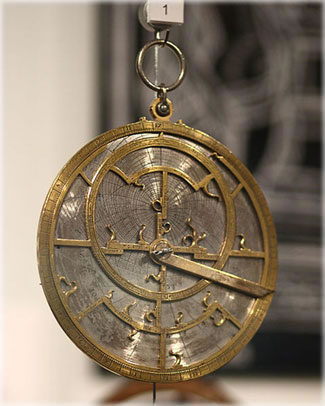
Astrology draws on knowledge from many different fields, including physics and astronomy. This astrolabe — which is a tool for making astronomical calculations — was crafted in the 15th century by the French instrument-maker Jean Fusoris (ca. 1365-1436).
Astrology is an unusual branch of knowledge in that doing it well requires a person to draw upon so many different fields. To name a few, in addition to astrology itself, we have to know about: astronomy, psychology, counseling, healing, metaphysics, some mathematics (less, now that there are computers), mythology, current events, history, relationships, sexuality and medicine. You would think that might take 20 years in a Greek academy.
To do astrology well, you can’t just know about these things — it’s necessary to integrate them into one another to put them into practical use. Speaking of practical, I had been going to conferences since 1995 and had never noticed a class focused on communications. After several years of lobbying the community, I was offered space to teach a writing class (sponsored by AFAN), which will be followed up by an Internet marketing/networking class taught by Donna Woodwell. AFAN is also sponsoring a media and public relations panel. These are excellent steps in the right direction.
While we’re on the topic, I would like to make a few suggestions for how conferences might contribute to better astrological education. I propose the following programs or concepts, which could be taught in a diversity of direct participation and workshop formats. It’s important to have the right format for the right kind of study. Some things work fine as lectures; others require a more roundtable or seminar-style approach.
Invite non-astrologer therapists to talk about how to work in a counseling room setting. Nearly all contemporary astrologers serve as counselors, even though most don’t call themselves that. We’re expected to help our clients through divorces, personal losses, illnesses, working out relationships, bouts of depression. Counseling comes with the astrological territory. I propose that we recruit some of the more innovative voices from progressive therapy projects and explore working with people as people rather than as extensions of their chart.
We need a real conversation about ethics. In medicine, the practitioner is supposed to try to do no harm. In matters of ethics in astrology, is it enough for the astrologer to suggest that the client consider the ethical considerations of his or her choice (such as a financial investment)? Should the astrologer actually decline to offer certain astrological advice and timing that might cause harm? Should the astrologer turn down clients seeking astrological advice to better exploit someone or the environment? Is it ethical to write about the charts of famous people, without their consent? These, and other questions, are fodder for our real conversation about ethics.
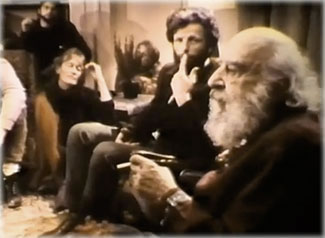
Astrology needs innovators of therapy to help us figure out how to best work with people. This is Fritz Perls, one of the creators of Gestalt therapy, working in group process, ca 1970s. Perhaps it’s my background with Gestalt therapy, but I have always thought of the astrology chart and especially transits resonating with the immediacy and holistic quality of this modality.
Open up the discussion of modern astrology. During the past 20 years, the profession has developed a fixation on ancient astrology. The presence of informed scholars and greatly improved translations of old texts is a beautiful thing — beyond amazing, if you think about it. The reverence for tradition is honorable, healing something at the roots of the crisis that contemporary astrology finds itself in. Yet the solar system has changed profoundly in those same few decades. If you came to any astrology conference hoping to find out more about the newly discovered planets (Eris, Quaoar, Varuna, Sedna, Chiron and the centaurs, for example) you would typically find token representation. On a related theme — we can do a lot more with deep-space points (galaxies, pulsars, quasars). There are some great teachers who are doing alive, original work we can all benefit from.
Cultivate better Sun sign writers. Sun sign writers — that is, the people who write the horoscopes in newspapers and magazines — are astrology’s most visible practitioners. Though many astrologers look askance at, or openly put down this modality, in fact, we reach more people than all of them combined. My theory is to put the very best astrology writers into positions where a broad audience is involved. Sun sign astrology depends on two skills — interpretation and communication. It’s where the proverbial rubber meets the road — what makes astrology worth all the bother. Conferences can offer classes on how to write better Sun sign columns, tapping into the truly amazing potential of this form of astrology to make a difference in people’s lives.
Focus on sex. Many clients have pressing questions about sex, and the complex sexual histories they are sometimes working through — and there are few places to actually have the conversation. An astrologer is a logical place to go, but how many of us have specific training or advanced knowledge in this area? How can we create a safe space for the conversation? What if you’re discussing sexuality with a client who is making your mouth water? How do you help someone figure out what is healthy for them, if that’s what you’re called upon to do? If you’re not gay yourself, how do you work with someone who is coming out of the closet? There is a fantastic on-the-ground movement of sex educators in the United States, many of whom are already on the speaking circuit — and we need to tap this community to educate astrologers. We need some of these speakers as keynote presenters.
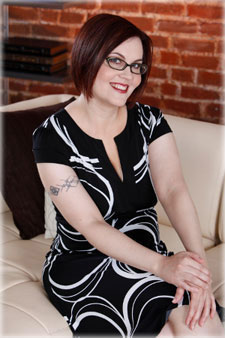
I nominate Tristan Taormino to be the first sex education keynote speaker for the astrology community. She is a Phi Beta Kappa graduate of Wesleyan, the niece of Thomas Pynchon, and a fantastic, enlightened sex education presenter. Publicity photo.
It’s time to provide astrologers with education about non-traditional relationship models. I have yet to see an astrology textbook that mentions polyamory, non-monogamous or other non-traditional relationship models. Yet many people are interested in these things, and lots of others are doing them without any special knowledge. It is readily available — another field with an active speaker’s circuit.
Are astrologers working from knowledge or belief? Do prominent Aquarian placements and/or prominent Uranus really indicate an enlightened, politically left ‘progressive’? Where are the statistical studies? We may need to put a disclaimer on the label. That said, reading a chart is a spontaneous and original experience, with all the factors taken in their unique context. It’s possible to teach something about how to do this.
Explore the use of astrology as a self-discovery tool. Most of our astrology is other-centered, yet a great many people use astrology as a self-discovery tool. It makes an excellent one — a kind of self-study spirituality game. Astrology is just one such path, though many others on other journeys might benefit from the self-reflexive learning from their charts. Here is an opportunity for astrology to cross-pollinate with other branches of modern spirituality.
How about real depth psychology training? Everyone agrees that astropsychobabble is not enough. The principles of depth psychology can be imparted in a series of classes, and study continued independently. For this I would propose non-astrological presenters, followed up by the most open-minded astrological presenters.
Working within the client’s religious framework. Astrologers work with people from diverse religious backgrounds. Religion is all the rage these days — and deep down, everyone has one. When you’re working with a devout Catholic, someone who is passionately Jewish or someone who is Hindu, it helps to be able to speak their spiritual language and work from within their frame of reference. It helps to understand the way they were taught metaphysical laws when they were a child. I propose that UAC and other conferences create a comparative religion track, and learn the role of astrology within the different approaches these religions take.

Dr. Brian Marsden was director of the Minor Planet Center and helped out astrology many times, providing the first ephemeris of Chiron to astrologer Zane Stein. Marsden died in 2010. Photo by Harold Dorwin.
Get some astronomers on board. Minor planet astrologers (starting with Zane Stein) have a tradition of being friends with astronomers — and we have learned a lot from one another. Yes, there are actually some astronomers who are intrigued by what we’re doing. Astrologers would benefit from hearing about the latest advances in astronomy from the scientists themselves. Our profession has astronomy as its main basis, and this is a field where there has been astonishing growth and development the past 20 or so years. Let’s get together!
The environment is in distress — and we are all impacted by the situation. Just like there is no separating astrology from astronomy, there is no separating what we do from the condition of the Earth. Every single person we work with is impacted in some way, and there is a deep layer of grief that many people experience as we watch the devastation of the planet. Often that comes with a feeling of helplessness, yet this whole condition often drops back as the client’s personal affairs occupy the foreground. Many therapy methods encourage people not to think about the world — only to take care of themselves. We are, fortunately, evolving past a place where that’s even possible, and where the distinction is irrelevant.
Astrologers need business training. Every astrology practice is a small business, and it’s not so easy to run one of those. What’s the best way for someone to organize their business structure, and how do they decide? How do you set up the practice, your office and your schedule? At what point is it a good idea to hire an assistant, and how do you do that? This would be a fantastic full-day intensive, with many topics suitable for lecture sessions.

Data collection and verification has gone downhill since we lost the magnificent Lois Rodden. Astrology needs to refocus its efforts on data collection, particularly of younger celebrities. Photo from Lois’s page on the Astrologer’s Memorial.
Create a lavish conference resource center. Imagine a room (like a ballroom or large conference room) with wide tables and a bunch of computers equipped with charting software, ephemerides, dials and other basic tools of the trade — set up on large tables. This would be staffed by experienced volunteer astrologers who could assist less experienced students with practical guidance and hands-on-the-work training in an informal format. You would be able to get help with your chart, seek tutoring in a special area of interest, learn how to use tools and have an intelligent one-on-one or small group conversation. This idea is stolen directly from John Dewey High School.
Astrological writing will benefit from fact-checking and attribution. Astrology stands halfway between the folk tradition and academic tradition. In folk tradition you can steal outright. In academic tradition, you usually attribute. While much of our knowledge is passed through the ages, some of it came out yesterday. We need to study, develop and teach the different modes of attribution. Also, data verification and collection has gone downhill steadily since the passing of Lois Rodden. This is an art that needs to be revived and honored by being taught.
What is astrology for? How does it work? And why do we use it? In order to use a tool safely, ethically and effectively, it’s necessary to understand how it works, and if that’s not possible, to be clear with ourselves how we think it works — and then explore the implications of that. Astrology often takes itself for granted, and rarely reflects on its failures, its shortcomings and its potential as a tool to approach life in a more holistic way.
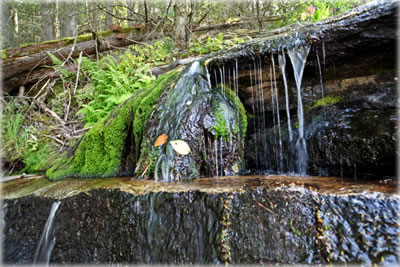
Astrology is part of the natural order of life, and could be considered a branch of environmental study. Astrologers would benefit from deepening their knowledge of earthy nature, and also understanding the impact of toxins on the environment. Photo by Eric.
It’s time to stop driving astrologers into debt to teach at conferences. Thanks to our subscribers, we at Planet Waves can afford to travel to conferences fully equipped and ready to go — but many astrologers must put the expenses on a credit card and pay it off. Some conferences pay better than others — though often presenters run at a significant loss, while the conference itself runs at a profit. If we’re going to have presenters already on the circuit or who come from outside our field, we will need to create the budget for that.
Astrologers fancy themselves intelligent people, equipped with one of the most sophisticated analytical tools in existence. Okay then, let’s figure this out.
While I’m at UAC I will be looking for people who can shed light on some of these topics, and if they’re game, I will share the interviews with you. Don’t forget to watch our Daily Astrology & Adventure page as well as Planet Waves FM starting midweek for our coverage of the United Astrology Conference.
Lovingly,
Additional writing: Dale O’Brien.
Posted in 2013 Resources Area
Leave a comment




